Remuneration Systems Analysis: Person-Based, Position-Based Pay
VerifiedAdded on 2021/04/21
|11
|2356
|438
Report
AI Summary
This report provides a comprehensive analysis of remuneration systems, focusing on person-based and position-based pay models. It begins by defining remuneration and its role in employee compensation, then delves into the core elements and drivers of each system. The report explores the advantages and disadvantages of both person-based pay, which rewards employees based on skills and qualifications, and position-based pay, which ties compensation to performance. It uses the case of O'Meara Electronics Company to illustrate the practical application of these systems, highlighting the challenges faced by the company with its current position-based approach. The analysis extends to evaluating the current system, recommending a hybrid approach that combines elements of both person-based and position-based pay to optimize employee motivation and organizational performance. The report concludes by emphasizing the importance of aligning remuneration systems with organizational goals and individual employee attributes for overall success. The report also provides relevant references to support the analysis.

Running head: Advance Remuneration and Performance 1
ADVANCE REMUNERATION AND PERFORMANCE
Student Name
Institution
ADVANCE REMUNERATION AND PERFORMANCE
Student Name
Institution
Paraphrase This Document
Need a fresh take? Get an instant paraphrase of this document with our AI Paraphraser
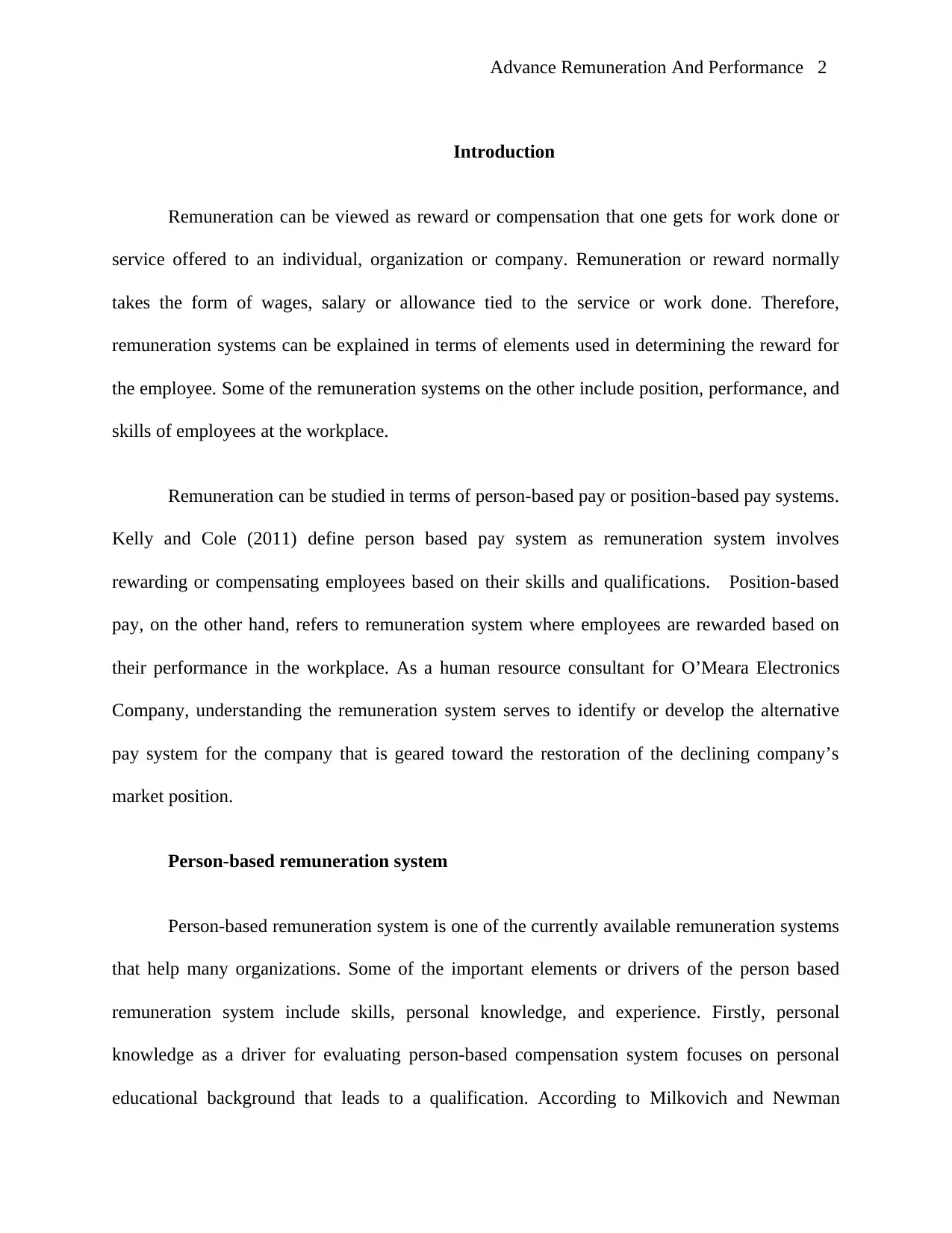
Advance Remuneration And Performance 2
Introduction
Remuneration can be viewed as reward or compensation that one gets for work done or
service offered to an individual, organization or company. Remuneration or reward normally
takes the form of wages, salary or allowance tied to the service or work done. Therefore,
remuneration systems can be explained in terms of elements used in determining the reward for
the employee. Some of the remuneration systems on the other include position, performance, and
skills of employees at the workplace.
Remuneration can be studied in terms of person-based pay or position-based pay systems.
Kelly and Cole (2011) define person based pay system as remuneration system involves
rewarding or compensating employees based on their skills and qualifications. Position-based
pay, on the other hand, refers to remuneration system where employees are rewarded based on
their performance in the workplace. As a human resource consultant for O’Meara Electronics
Company, understanding the remuneration system serves to identify or develop the alternative
pay system for the company that is geared toward the restoration of the declining company’s
market position.
Person-based remuneration system
Person-based remuneration system is one of the currently available remuneration systems
that help many organizations. Some of the important elements or drivers of the person based
remuneration system include skills, personal knowledge, and experience. Firstly, personal
knowledge as a driver for evaluating person-based compensation system focuses on personal
educational background that leads to a qualification. According to Milkovich and Newman
Introduction
Remuneration can be viewed as reward or compensation that one gets for work done or
service offered to an individual, organization or company. Remuneration or reward normally
takes the form of wages, salary or allowance tied to the service or work done. Therefore,
remuneration systems can be explained in terms of elements used in determining the reward for
the employee. Some of the remuneration systems on the other include position, performance, and
skills of employees at the workplace.
Remuneration can be studied in terms of person-based pay or position-based pay systems.
Kelly and Cole (2011) define person based pay system as remuneration system involves
rewarding or compensating employees based on their skills and qualifications. Position-based
pay, on the other hand, refers to remuneration system where employees are rewarded based on
their performance in the workplace. As a human resource consultant for O’Meara Electronics
Company, understanding the remuneration system serves to identify or develop the alternative
pay system for the company that is geared toward the restoration of the declining company’s
market position.
Person-based remuneration system
Person-based remuneration system is one of the currently available remuneration systems
that help many organizations. Some of the important elements or drivers of the person based
remuneration system include skills, personal knowledge, and experience. Firstly, personal
knowledge as a driver for evaluating person-based compensation system focuses on personal
educational background that leads to a qualification. According to Milkovich and Newman
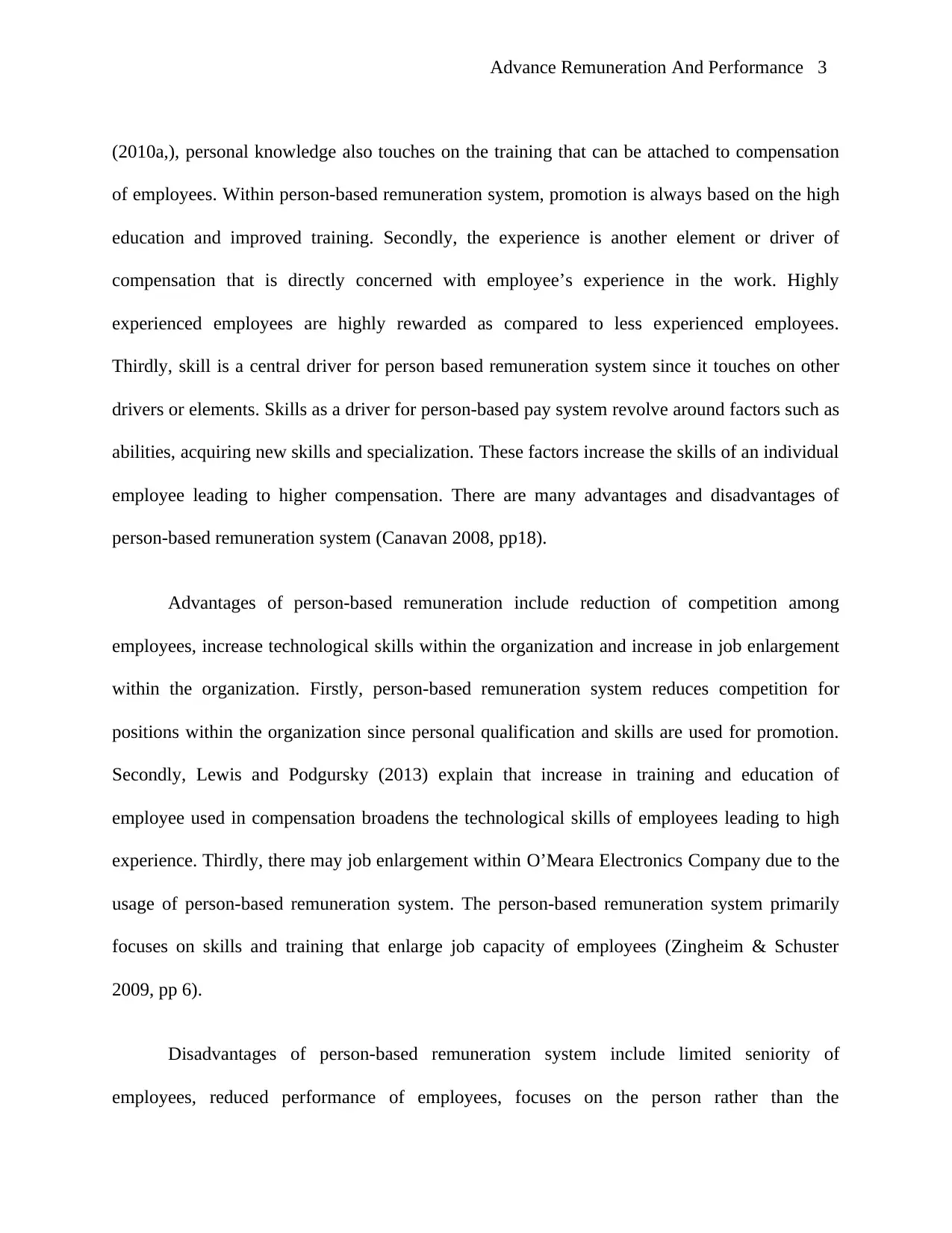
Advance Remuneration And Performance 3
(2010a,), personal knowledge also touches on the training that can be attached to compensation
of employees. Within person-based remuneration system, promotion is always based on the high
education and improved training. Secondly, the experience is another element or driver of
compensation that is directly concerned with employee’s experience in the work. Highly
experienced employees are highly rewarded as compared to less experienced employees.
Thirdly, skill is a central driver for person based remuneration system since it touches on other
drivers or elements. Skills as a driver for person-based pay system revolve around factors such as
abilities, acquiring new skills and specialization. These factors increase the skills of an individual
employee leading to higher compensation. There are many advantages and disadvantages of
person-based remuneration system (Canavan 2008, pp18).
Advantages of person-based remuneration include reduction of competition among
employees, increase technological skills within the organization and increase in job enlargement
within the organization. Firstly, person-based remuneration system reduces competition for
positions within the organization since personal qualification and skills are used for promotion.
Secondly, Lewis and Podgursky (2013) explain that increase in training and education of
employee used in compensation broadens the technological skills of employees leading to high
experience. Thirdly, there may job enlargement within O’Meara Electronics Company due to the
usage of person-based remuneration system. The person-based remuneration system primarily
focuses on skills and training that enlarge job capacity of employees (Zingheim & Schuster
2009, pp 6).
Disadvantages of person-based remuneration system include limited seniority of
employees, reduced performance of employees, focuses on the person rather than the
(2010a,), personal knowledge also touches on the training that can be attached to compensation
of employees. Within person-based remuneration system, promotion is always based on the high
education and improved training. Secondly, the experience is another element or driver of
compensation that is directly concerned with employee’s experience in the work. Highly
experienced employees are highly rewarded as compared to less experienced employees.
Thirdly, skill is a central driver for person based remuneration system since it touches on other
drivers or elements. Skills as a driver for person-based pay system revolve around factors such as
abilities, acquiring new skills and specialization. These factors increase the skills of an individual
employee leading to higher compensation. There are many advantages and disadvantages of
person-based remuneration system (Canavan 2008, pp18).
Advantages of person-based remuneration include reduction of competition among
employees, increase technological skills within the organization and increase in job enlargement
within the organization. Firstly, person-based remuneration system reduces competition for
positions within the organization since personal qualification and skills are used for promotion.
Secondly, Lewis and Podgursky (2013) explain that increase in training and education of
employee used in compensation broadens the technological skills of employees leading to high
experience. Thirdly, there may job enlargement within O’Meara Electronics Company due to the
usage of person-based remuneration system. The person-based remuneration system primarily
focuses on skills and training that enlarge job capacity of employees (Zingheim & Schuster
2009, pp 6).
Disadvantages of person-based remuneration system include limited seniority of
employees, reduced performance of employees, focuses on the person rather than the
⊘ This is a preview!⊘
Do you want full access?
Subscribe today to unlock all pages.

Trusted by 1+ million students worldwide
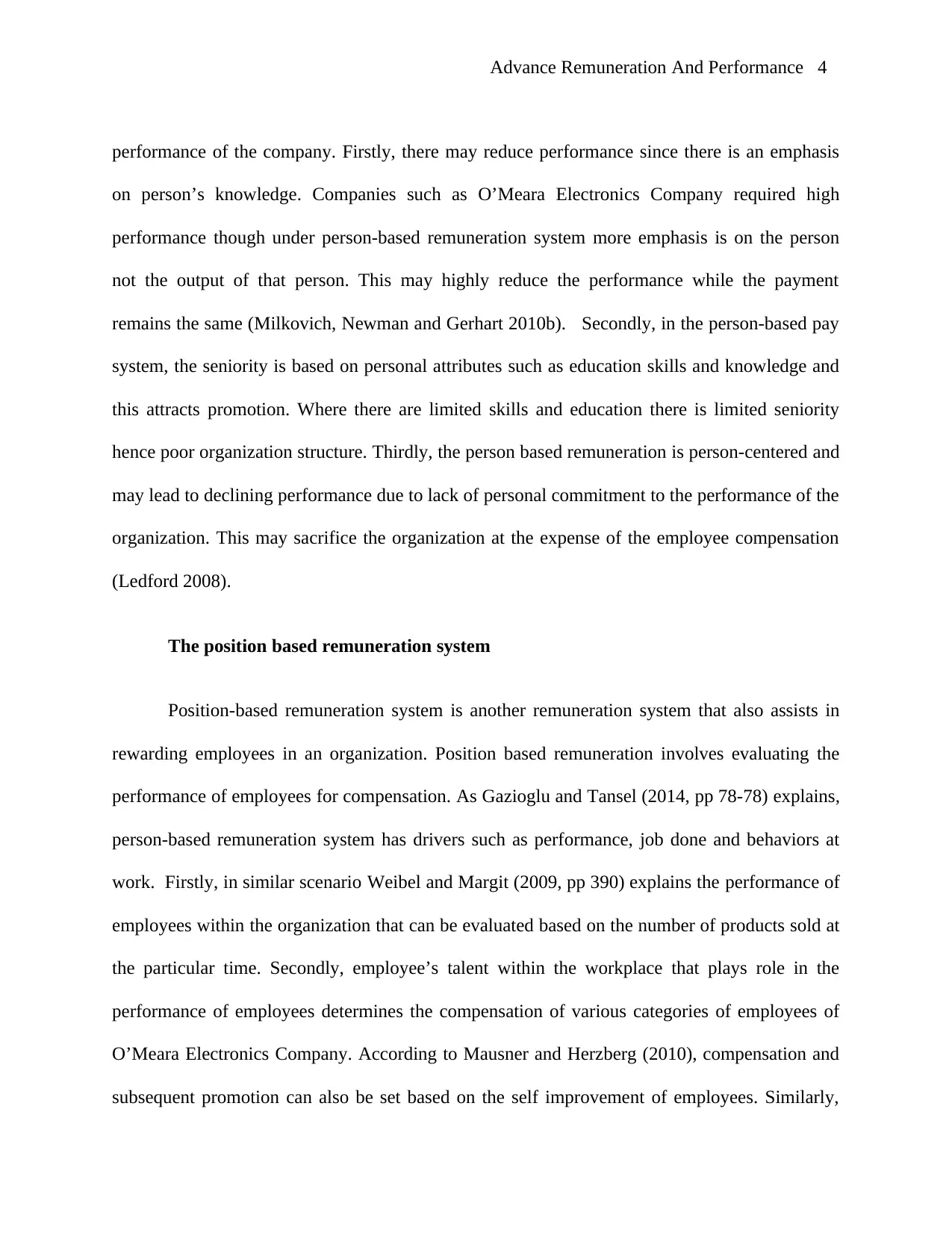
Advance Remuneration And Performance 4
performance of the company. Firstly, there may reduce performance since there is an emphasis
on person’s knowledge. Companies such as O’Meara Electronics Company required high
performance though under person-based remuneration system more emphasis is on the person
not the output of that person. This may highly reduce the performance while the payment
remains the same (Milkovich, Newman and Gerhart 2010b). Secondly, in the person-based pay
system, the seniority is based on personal attributes such as education skills and knowledge and
this attracts promotion. Where there are limited skills and education there is limited seniority
hence poor organization structure. Thirdly, the person based remuneration is person-centered and
may lead to declining performance due to lack of personal commitment to the performance of the
organization. This may sacrifice the organization at the expense of the employee compensation
(Ledford 2008).
The position based remuneration system
Position-based remuneration system is another remuneration system that also assists in
rewarding employees in an organization. Position based remuneration involves evaluating the
performance of employees for compensation. As Gazioglu and Tansel (2014, pp 78-78) explains,
person-based remuneration system has drivers such as performance, job done and behaviors at
work. Firstly, in similar scenario Weibel and Margit (2009, pp 390) explains the performance of
employees within the organization that can be evaluated based on the number of products sold at
the particular time. Secondly, employee’s talent within the workplace that plays role in the
performance of employees determines the compensation of various categories of employees of
O’Meara Electronics Company. According to Mausner and Herzberg (2010), compensation and
subsequent promotion can also be set based on the self improvement of employees. Similarly,
performance of the company. Firstly, there may reduce performance since there is an emphasis
on person’s knowledge. Companies such as O’Meara Electronics Company required high
performance though under person-based remuneration system more emphasis is on the person
not the output of that person. This may highly reduce the performance while the payment
remains the same (Milkovich, Newman and Gerhart 2010b). Secondly, in the person-based pay
system, the seniority is based on personal attributes such as education skills and knowledge and
this attracts promotion. Where there are limited skills and education there is limited seniority
hence poor organization structure. Thirdly, the person based remuneration is person-centered and
may lead to declining performance due to lack of personal commitment to the performance of the
organization. This may sacrifice the organization at the expense of the employee compensation
(Ledford 2008).
The position based remuneration system
Position-based remuneration system is another remuneration system that also assists in
rewarding employees in an organization. Position based remuneration involves evaluating the
performance of employees for compensation. As Gazioglu and Tansel (2014, pp 78-78) explains,
person-based remuneration system has drivers such as performance, job done and behaviors at
work. Firstly, in similar scenario Weibel and Margit (2009, pp 390) explains the performance of
employees within the organization that can be evaluated based on the number of products sold at
the particular time. Secondly, employee’s talent within the workplace that plays role in the
performance of employees determines the compensation of various categories of employees of
O’Meara Electronics Company. According to Mausner and Herzberg (2010), compensation and
subsequent promotion can also be set based on the self improvement of employees. Similarly,
Paraphrase This Document
Need a fresh take? Get an instant paraphrase of this document with our AI Paraphraser
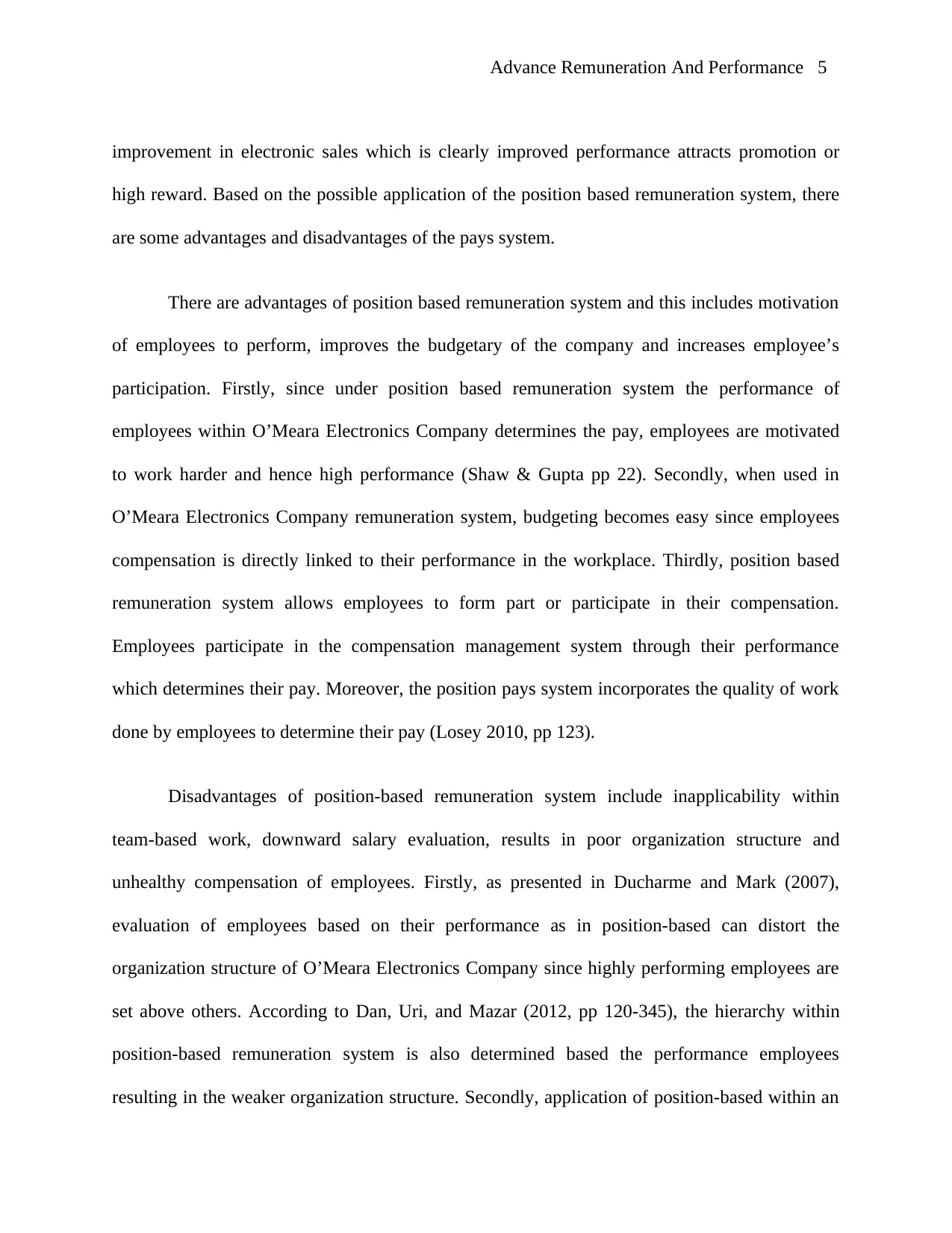
Advance Remuneration And Performance 5
improvement in electronic sales which is clearly improved performance attracts promotion or
high reward. Based on the possible application of the position based remuneration system, there
are some advantages and disadvantages of the pays system.
There are advantages of position based remuneration system and this includes motivation
of employees to perform, improves the budgetary of the company and increases employee’s
participation. Firstly, since under position based remuneration system the performance of
employees within O’Meara Electronics Company determines the pay, employees are motivated
to work harder and hence high performance (Shaw & Gupta pp 22). Secondly, when used in
O’Meara Electronics Company remuneration system, budgeting becomes easy since employees
compensation is directly linked to their performance in the workplace. Thirdly, position based
remuneration system allows employees to form part or participate in their compensation.
Employees participate in the compensation management system through their performance
which determines their pay. Moreover, the position pays system incorporates the quality of work
done by employees to determine their pay (Losey 2010, pp 123).
Disadvantages of position-based remuneration system include inapplicability within
team-based work, downward salary evaluation, results in poor organization structure and
unhealthy compensation of employees. Firstly, as presented in Ducharme and Mark (2007),
evaluation of employees based on their performance as in position-based can distort the
organization structure of O’Meara Electronics Company since highly performing employees are
set above others. According to Dan, Uri, and Mazar (2012, pp 120-345), the hierarchy within
position-based remuneration system is also determined based the performance employees
resulting in the weaker organization structure. Secondly, application of position-based within an
improvement in electronic sales which is clearly improved performance attracts promotion or
high reward. Based on the possible application of the position based remuneration system, there
are some advantages and disadvantages of the pays system.
There are advantages of position based remuneration system and this includes motivation
of employees to perform, improves the budgetary of the company and increases employee’s
participation. Firstly, since under position based remuneration system the performance of
employees within O’Meara Electronics Company determines the pay, employees are motivated
to work harder and hence high performance (Shaw & Gupta pp 22). Secondly, when used in
O’Meara Electronics Company remuneration system, budgeting becomes easy since employees
compensation is directly linked to their performance in the workplace. Thirdly, position based
remuneration system allows employees to form part or participate in their compensation.
Employees participate in the compensation management system through their performance
which determines their pay. Moreover, the position pays system incorporates the quality of work
done by employees to determine their pay (Losey 2010, pp 123).
Disadvantages of position-based remuneration system include inapplicability within
team-based work, downward salary evaluation, results in poor organization structure and
unhealthy compensation of employees. Firstly, as presented in Ducharme and Mark (2007),
evaluation of employees based on their performance as in position-based can distort the
organization structure of O’Meara Electronics Company since highly performing employees are
set above others. According to Dan, Uri, and Mazar (2012, pp 120-345), the hierarchy within
position-based remuneration system is also determined based the performance employees
resulting in the weaker organization structure. Secondly, application of position-based within an
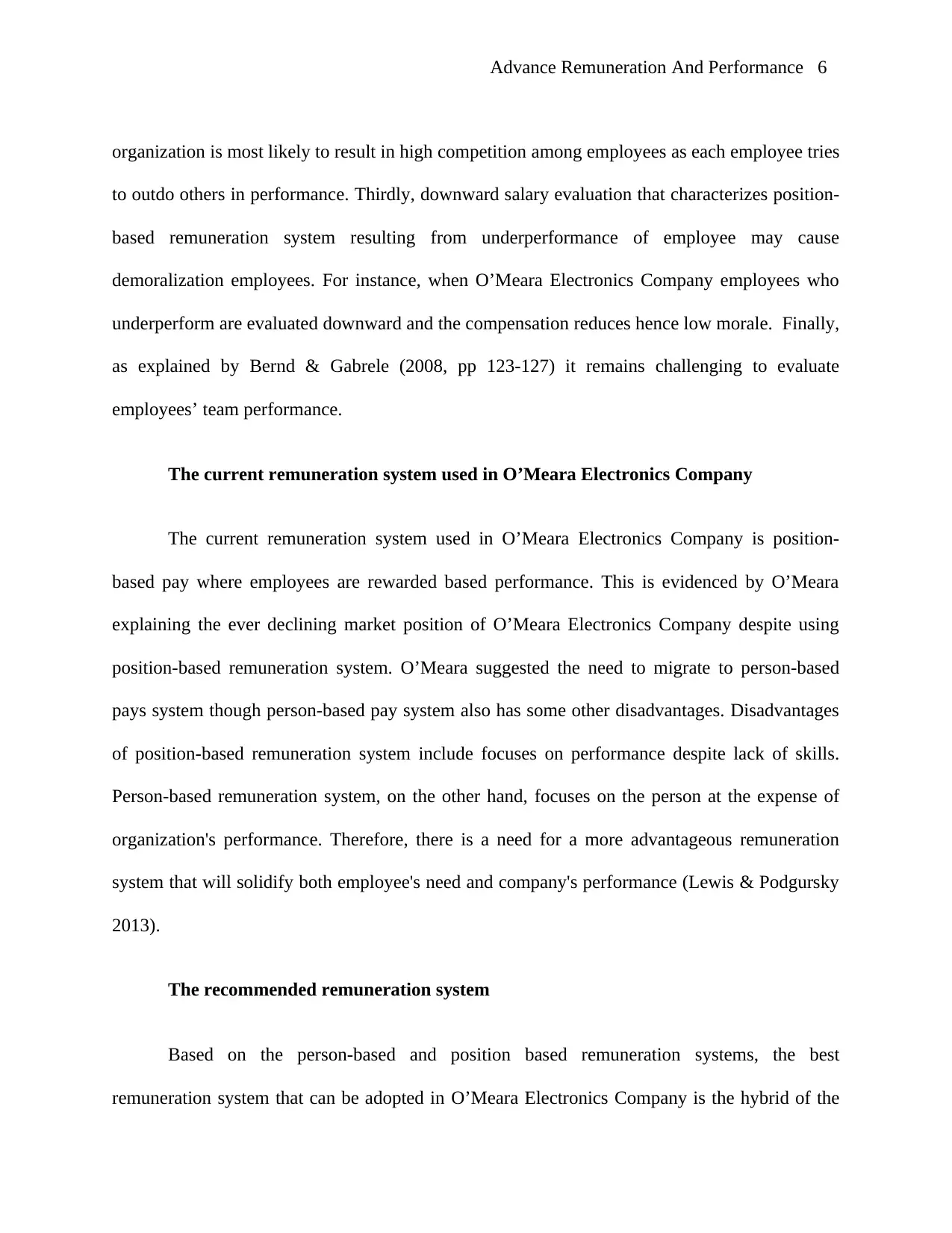
Advance Remuneration And Performance 6
organization is most likely to result in high competition among employees as each employee tries
to outdo others in performance. Thirdly, downward salary evaluation that characterizes position-
based remuneration system resulting from underperformance of employee may cause
demoralization employees. For instance, when O’Meara Electronics Company employees who
underperform are evaluated downward and the compensation reduces hence low morale. Finally,
as explained by Bernd & Gabrele (2008, pp 123-127) it remains challenging to evaluate
employees’ team performance.
The current remuneration system used in O’Meara Electronics Company
The current remuneration system used in O’Meara Electronics Company is position-
based pay where employees are rewarded based performance. This is evidenced by O’Meara
explaining the ever declining market position of O’Meara Electronics Company despite using
position-based remuneration system. O’Meara suggested the need to migrate to person-based
pays system though person-based pay system also has some other disadvantages. Disadvantages
of position-based remuneration system include focuses on performance despite lack of skills.
Person-based remuneration system, on the other hand, focuses on the person at the expense of
organization's performance. Therefore, there is a need for a more advantageous remuneration
system that will solidify both employee's need and company's performance (Lewis & Podgursky
2013).
The recommended remuneration system
Based on the person-based and position based remuneration systems, the best
remuneration system that can be adopted in O’Meara Electronics Company is the hybrid of the
organization is most likely to result in high competition among employees as each employee tries
to outdo others in performance. Thirdly, downward salary evaluation that characterizes position-
based remuneration system resulting from underperformance of employee may cause
demoralization employees. For instance, when O’Meara Electronics Company employees who
underperform are evaluated downward and the compensation reduces hence low morale. Finally,
as explained by Bernd & Gabrele (2008, pp 123-127) it remains challenging to evaluate
employees’ team performance.
The current remuneration system used in O’Meara Electronics Company
The current remuneration system used in O’Meara Electronics Company is position-
based pay where employees are rewarded based performance. This is evidenced by O’Meara
explaining the ever declining market position of O’Meara Electronics Company despite using
position-based remuneration system. O’Meara suggested the need to migrate to person-based
pays system though person-based pay system also has some other disadvantages. Disadvantages
of position-based remuneration system include focuses on performance despite lack of skills.
Person-based remuneration system, on the other hand, focuses on the person at the expense of
organization's performance. Therefore, there is a need for a more advantageous remuneration
system that will solidify both employee's need and company's performance (Lewis & Podgursky
2013).
The recommended remuneration system
Based on the person-based and position based remuneration systems, the best
remuneration system that can be adopted in O’Meara Electronics Company is the hybrid of the
⊘ This is a preview!⊘
Do you want full access?
Subscribe today to unlock all pages.

Trusted by 1+ million students worldwide
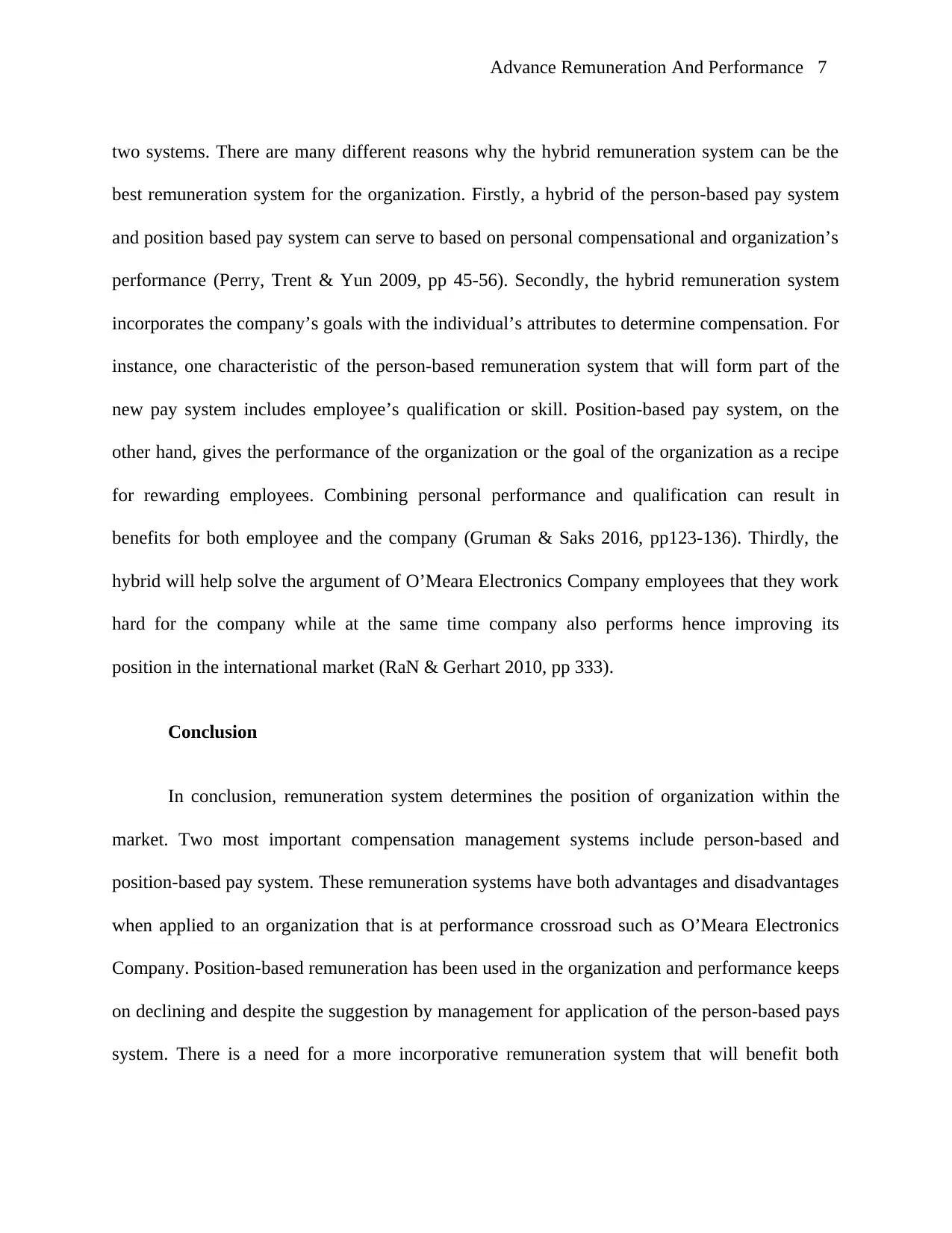
Advance Remuneration And Performance 7
two systems. There are many different reasons why the hybrid remuneration system can be the
best remuneration system for the organization. Firstly, a hybrid of the person-based pay system
and position based pay system can serve to based on personal compensational and organization’s
performance (Perry, Trent & Yun 2009, pp 45-56). Secondly, the hybrid remuneration system
incorporates the company’s goals with the individual’s attributes to determine compensation. For
instance, one characteristic of the person-based remuneration system that will form part of the
new pay system includes employee’s qualification or skill. Position-based pay system, on the
other hand, gives the performance of the organization or the goal of the organization as a recipe
for rewarding employees. Combining personal performance and qualification can result in
benefits for both employee and the company (Gruman & Saks 2016, pp123-136). Thirdly, the
hybrid will help solve the argument of O’Meara Electronics Company employees that they work
hard for the company while at the same time company also performs hence improving its
position in the international market (RaN & Gerhart 2010, pp 333).
Conclusion
In conclusion, remuneration system determines the position of organization within the
market. Two most important compensation management systems include person-based and
position-based pay system. These remuneration systems have both advantages and disadvantages
when applied to an organization that is at performance crossroad such as O’Meara Electronics
Company. Position-based remuneration has been used in the organization and performance keeps
on declining and despite the suggestion by management for application of the person-based pays
system. There is a need for a more incorporative remuneration system that will benefit both
two systems. There are many different reasons why the hybrid remuneration system can be the
best remuneration system for the organization. Firstly, a hybrid of the person-based pay system
and position based pay system can serve to based on personal compensational and organization’s
performance (Perry, Trent & Yun 2009, pp 45-56). Secondly, the hybrid remuneration system
incorporates the company’s goals with the individual’s attributes to determine compensation. For
instance, one characteristic of the person-based remuneration system that will form part of the
new pay system includes employee’s qualification or skill. Position-based pay system, on the
other hand, gives the performance of the organization or the goal of the organization as a recipe
for rewarding employees. Combining personal performance and qualification can result in
benefits for both employee and the company (Gruman & Saks 2016, pp123-136). Thirdly, the
hybrid will help solve the argument of O’Meara Electronics Company employees that they work
hard for the company while at the same time company also performs hence improving its
position in the international market (RaN & Gerhart 2010, pp 333).
Conclusion
In conclusion, remuneration system determines the position of organization within the
market. Two most important compensation management systems include person-based and
position-based pay system. These remuneration systems have both advantages and disadvantages
when applied to an organization that is at performance crossroad such as O’Meara Electronics
Company. Position-based remuneration has been used in the organization and performance keeps
on declining and despite the suggestion by management for application of the person-based pays
system. There is a need for a more incorporative remuneration system that will benefit both
Paraphrase This Document
Need a fresh take? Get an instant paraphrase of this document with our AI Paraphraser
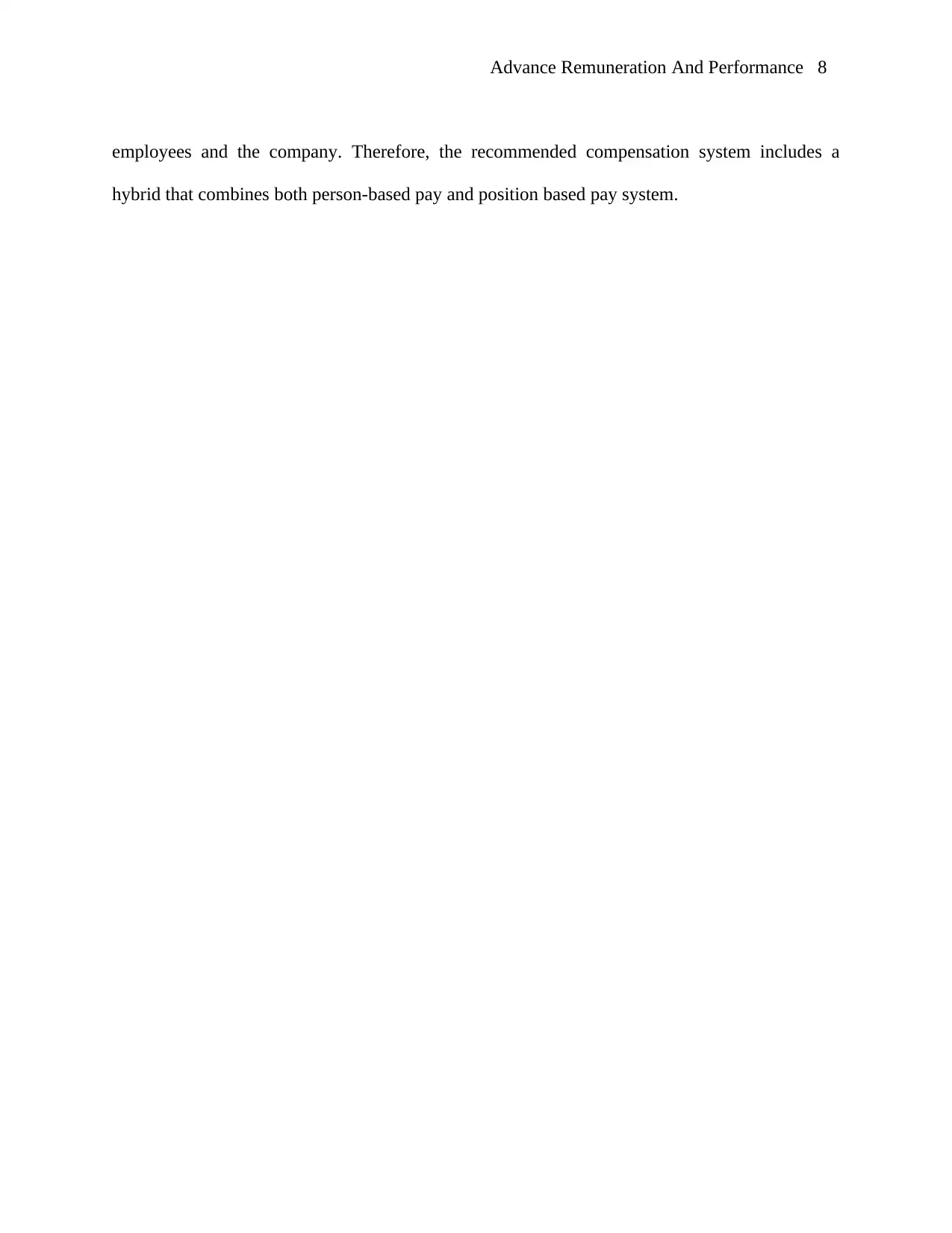
Advance Remuneration And Performance 8
employees and the company. Therefore, the recommended compensation system includes a
hybrid that combines both person-based pay and position based pay system.
employees and the company. Therefore, the recommended compensation system includes a
hybrid that combines both person-based pay and position based pay system.
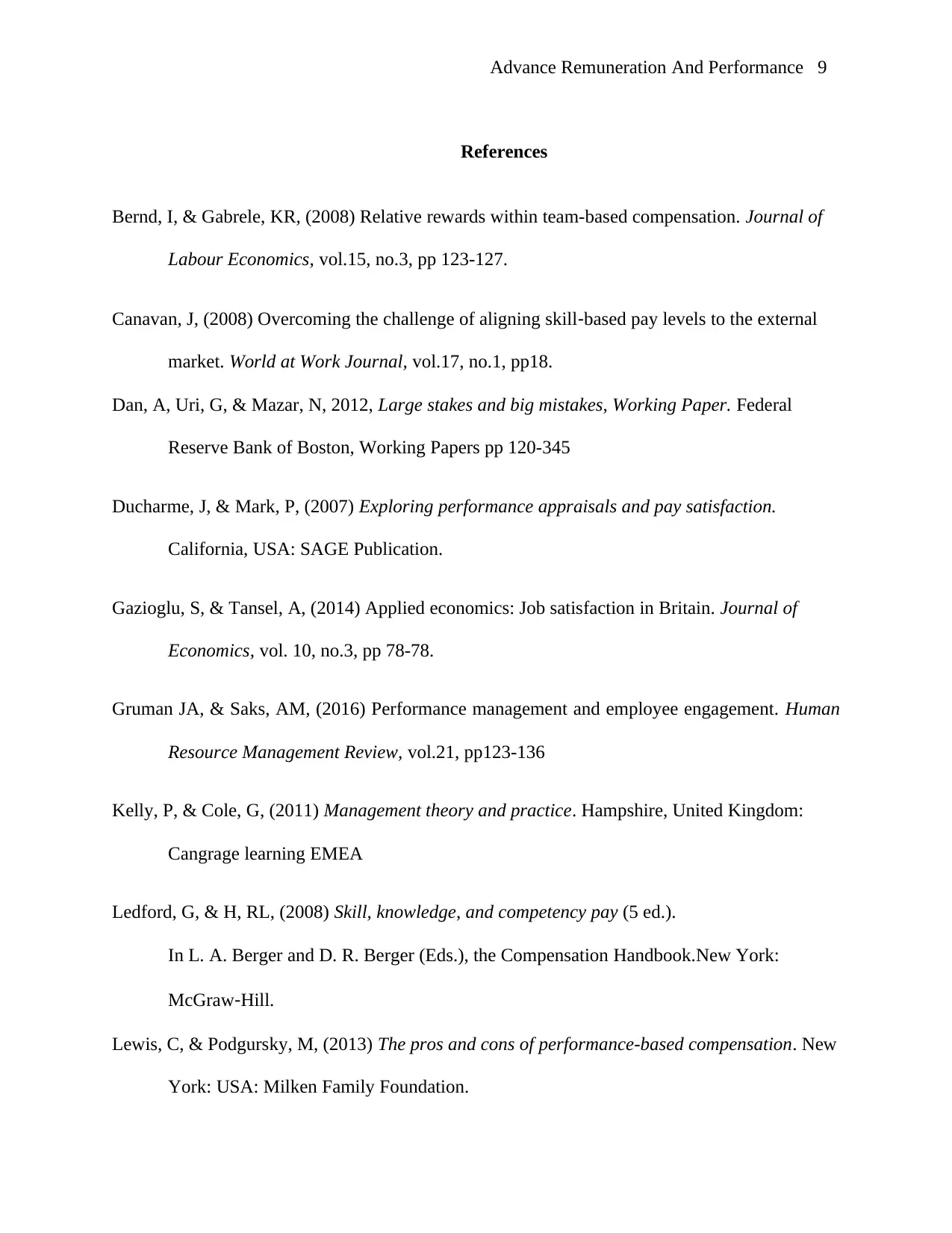
Advance Remuneration And Performance 9
References
Bernd, I, & Gabrele, KR, (2008) Relative rewards within team-based compensation. Journal of
Labour Economics, vol.15, no.3, pp 123-127.
Canavan, J, (2008) Overcoming the challenge of aligning skill‐based pay levels to the external
market. World at Work Journal, vol.17, no.1, pp18.
Dan, A, Uri, G, & Mazar, N, 2012, Large stakes and big mistakes, Working Paper. Federal
Reserve Bank of Boston, Working Papers pp 120-345
Ducharme, J, & Mark, P, (2007) Exploring performance appraisals and pay satisfaction.
California, USA: SAGE Publication.
Gazioglu, S, & Tansel, A, (2014) Applied economics: Job satisfaction in Britain. Journal of
Economics, vol. 10, no.3, pp 78-78.
Gruman JA, & Saks, AM, (2016) Performance management and employee engagement. Human
Resource Management Review, vol.21, pp123-136
Kelly, P, & Cole, G, (2011) Management theory and practice. Hampshire, United Kingdom:
Cangrage learning EMEA
Ledford, G, & H, RL, (2008) Skill, knowledge, and competency pay (5 ed.).
In L. A. Berger and D. R. Berger (Eds.), the Compensation Handbook.New York:
McGraw‐Hill.
Lewis, C, & Podgursky, M, (2013) The pros and cons of performance-based compensation. New
York: USA: Milken Family Foundation.
References
Bernd, I, & Gabrele, KR, (2008) Relative rewards within team-based compensation. Journal of
Labour Economics, vol.15, no.3, pp 123-127.
Canavan, J, (2008) Overcoming the challenge of aligning skill‐based pay levels to the external
market. World at Work Journal, vol.17, no.1, pp18.
Dan, A, Uri, G, & Mazar, N, 2012, Large stakes and big mistakes, Working Paper. Federal
Reserve Bank of Boston, Working Papers pp 120-345
Ducharme, J, & Mark, P, (2007) Exploring performance appraisals and pay satisfaction.
California, USA: SAGE Publication.
Gazioglu, S, & Tansel, A, (2014) Applied economics: Job satisfaction in Britain. Journal of
Economics, vol. 10, no.3, pp 78-78.
Gruman JA, & Saks, AM, (2016) Performance management and employee engagement. Human
Resource Management Review, vol.21, pp123-136
Kelly, P, & Cole, G, (2011) Management theory and practice. Hampshire, United Kingdom:
Cangrage learning EMEA
Ledford, G, & H, RL, (2008) Skill, knowledge, and competency pay (5 ed.).
In L. A. Berger and D. R. Berger (Eds.), the Compensation Handbook.New York:
McGraw‐Hill.
Lewis, C, & Podgursky, M, (2013) The pros and cons of performance-based compensation. New
York: USA: Milken Family Foundation.
⊘ This is a preview!⊘
Do you want full access?
Subscribe today to unlock all pages.

Trusted by 1+ million students worldwide
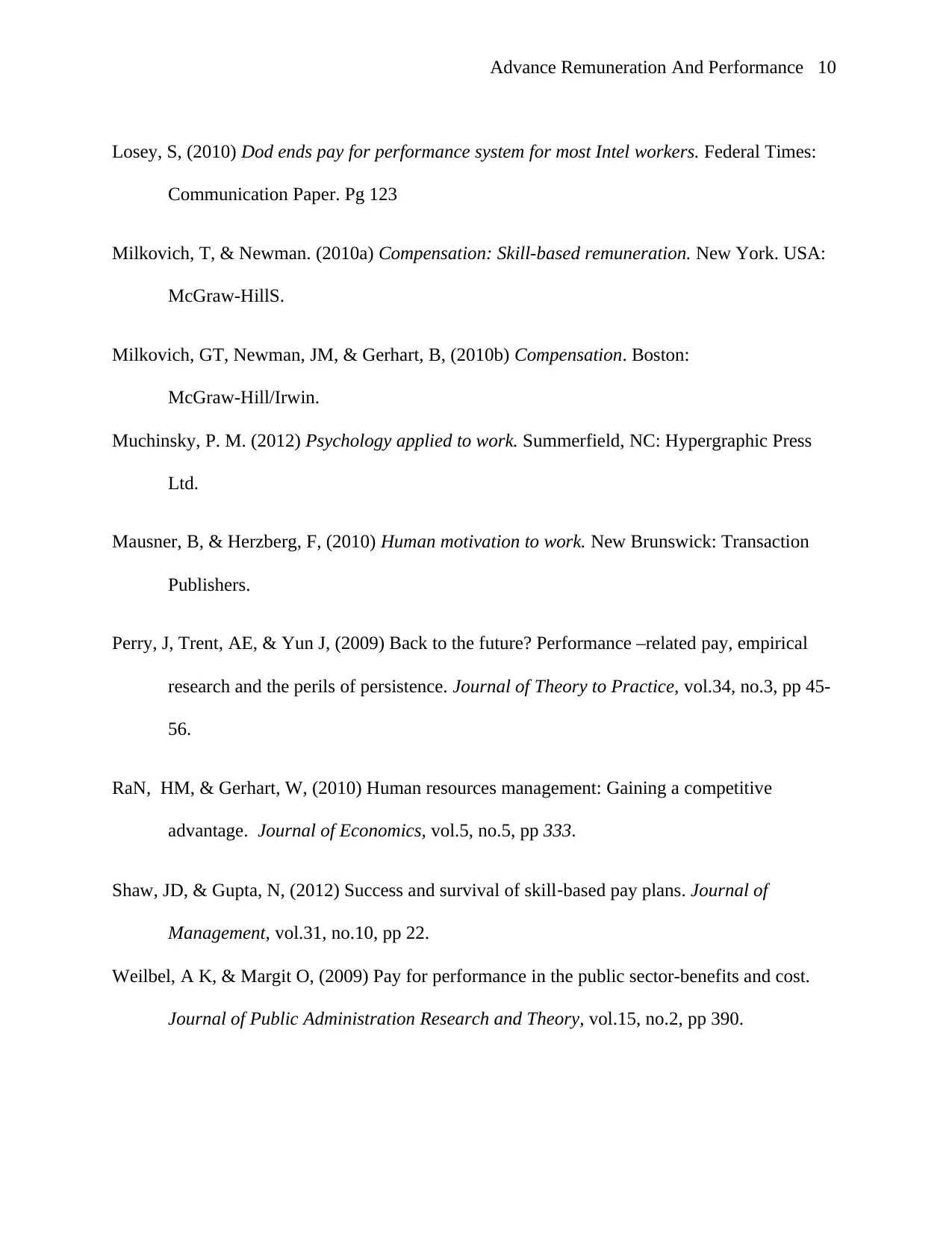
Advance Remuneration And Performance 10
Losey, S, (2010) Dod ends pay for performance system for most Intel workers. Federal Times:
Communication Paper. Pg 123
Milkovich, T, & Newman. (2010a) Compensation: Skill-based remuneration. New York. USA:
McGraw-HillS.
Milkovich, GT, Newman, JM, & Gerhart, B, (2010b) Compensation. Boston:
McGraw-Hill/Irwin.
Muchinsky, P. M. (2012) Psychology applied to work. Summerfield, NC: Hypergraphic Press
Ltd.
Mausner, B, & Herzberg, F, (2010) Human motivation to work. New Brunswick: Transaction
Publishers.
Perry, J, Trent, AE, & Yun J, (2009) Back to the future? Performance –related pay, empirical
research and the perils of persistence. Journal of Theory to Practice, vol.34, no.3, pp 45-
56.
RaN, HM, & Gerhart, W, (2010) Human resources management: Gaining a competitive
advantage. Journal of Economics, vol.5, no.5, pp 333.
Shaw, JD, & Gupta, N, (2012) Success and survival of skill‐based pay plans. Journal of
Management, vol.31, no.10, pp 22.
Weilbel, A K, & Margit O, (2009) Pay for performance in the public sector-benefits and cost.
Journal of Public Administration Research and Theory, vol.15, no.2, pp 390.
Losey, S, (2010) Dod ends pay for performance system for most Intel workers. Federal Times:
Communication Paper. Pg 123
Milkovich, T, & Newman. (2010a) Compensation: Skill-based remuneration. New York. USA:
McGraw-HillS.
Milkovich, GT, Newman, JM, & Gerhart, B, (2010b) Compensation. Boston:
McGraw-Hill/Irwin.
Muchinsky, P. M. (2012) Psychology applied to work. Summerfield, NC: Hypergraphic Press
Ltd.
Mausner, B, & Herzberg, F, (2010) Human motivation to work. New Brunswick: Transaction
Publishers.
Perry, J, Trent, AE, & Yun J, (2009) Back to the future? Performance –related pay, empirical
research and the perils of persistence. Journal of Theory to Practice, vol.34, no.3, pp 45-
56.
RaN, HM, & Gerhart, W, (2010) Human resources management: Gaining a competitive
advantage. Journal of Economics, vol.5, no.5, pp 333.
Shaw, JD, & Gupta, N, (2012) Success and survival of skill‐based pay plans. Journal of
Management, vol.31, no.10, pp 22.
Weilbel, A K, & Margit O, (2009) Pay for performance in the public sector-benefits and cost.
Journal of Public Administration Research and Theory, vol.15, no.2, pp 390.
Paraphrase This Document
Need a fresh take? Get an instant paraphrase of this document with our AI Paraphraser

Advance Remuneration And Performance 11
Zingheim, PK, & Schuster, JR, (2009) Competencies replace jobs as the compensation/hr
foundation. World at Work Journal, vol.18, no.3, pp 6.
Zingheim, PK, & Schuster, JR, (2009) Competencies replace jobs as the compensation/hr
foundation. World at Work Journal, vol.18, no.3, pp 6.
1 out of 11
Related Documents
Your All-in-One AI-Powered Toolkit for Academic Success.
+13062052269
info@desklib.com
Available 24*7 on WhatsApp / Email
![[object Object]](/_next/static/media/star-bottom.7253800d.svg)
Unlock your academic potential
Copyright © 2020–2025 A2Z Services. All Rights Reserved. Developed and managed by ZUCOL.




